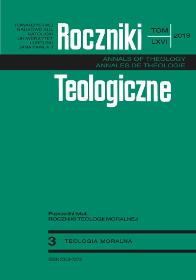On an Amendment of the Morality of a Physicist's Professional Actions. A New Element of Inculturation of Christianity into a Scientific-Technological Civilization
Abstract
Physicists are bound, by the established methods and standards of Physics, to think and act within an epistemological framework that is deeply influenced by I. Kant. The epistemological climate they find themselves in is opposed to the epistemological climate of Natural Realism and, thus, to the epistemological climate of Christian revelation, when it speaks about our world. This contrast damages the internal harmony of each physicist's mental world to a degree that depends on his overall mindset as well as on his professional work. This situation is ongoing since the Scientific Revolution of the 17th century, so that the earlier civilization imbued with a realist and Christian spirit is superseded, by and large, by a scientific-technological civilization.
The historical development of Physics has brought about the situation that the professional work of physicists produces, with its doubtless successes and contributions to progress, immediately together with its morally good object two enchained morally bad effects. The first bad effect is the co-existence, in a physicist's mind, of two opposite epistemological climates, which damages the internal harmony of his mental world. That immediately entails a second bad effect, insofar a physicist who wants to be professionally competitive finds himself obliged to follow the methods and standards of physics as they happen to be now. In that way, he contributes to the lack of harmony in his own mental world and his grain of sand to perpetuate the spirit of those methods and standards. The situation is worse for a physicist who is a Christian and wants to do his professional work for the glory of God (cf. 1 Cor 10:31). In both cases, a physicist is denying in practice, by his professional work, what he is convinced of in theory, namely of Natural Realism and, additionally in the case of a Christian, that Christian revelation speaks of our world in the spirit of Natural Realism.
All that is not unknown, but nevertheless is practically passed by in the academic discourse. Therefore, the purpose of this article is to call attention to this topic and then to suggest some ways of examining more specifically the contrast of the epistemological climates. As Physics is partly shaped by experimental interventions, its historical development is also partly contingent. This is why it is possible to achieve a better harmony of the epistemological climates of Physics and Natural Realism. The article suggests some ideas in that respect, too. If these ideas turn out to be fruitful, they would contribute to the inculturation of Christianity in our scientific-technological civilization. In other words, it would be a flanking aid for the New Evangelization.
References
Dijksterhuis, Eduard J. The Mechanization of the World Picture. Oxford: Oxford University Press, 1961.
First Vatican Council. Dogmatic Constitution Dei Filius.
Hartmann, Nicolai. Grundzüge einer Metaphysik der Erkenntnis. Berlin: Walter de Gruyter, 1965. The passages cited in the text are available online under https://books.google.fi/books?id=YaEhAAAAQBAJ&hl=fi&source=gbs_book_other_versions; click `Realistische Theorien'. Retrieved 10.06.2019.
Hawking, Stephen, Mlodinow, Leonid. The Grand Design – A New Explanation of the Universe. New York: Bantam Books (Random House), 2010.
Hertz, Heinrich. The Principles of Mechanics Presented in a New Form. London: Macmillan & Co. Ltd., 1899. Online: https://archive.org/details/principlesofmech00hertuoft/page/xxviii. Retrieved 11.06.2019.
Ioannes Paulus II. Encyclical Fides et ratio (1998).
Kant, Immanuel. Critique of pure Reason (first edition (1781) and second edition (1787)), www.earlymoderntexts.com/authors/kant/; ed. Jonathan Bennett. Retrieved 11.06.2019.
Larenz, Rudolf. Physics – `Alienation from' instead of `Orientation towards' the Creator? Roczniki Teologii Moralnej [Lublin] 2011, 3(58): 5-37. Online: http://cejsh.icm.edu.pl/cejsh/element/bwmeta1.element.desklight-92c8dcdd-f35a-44d5-818d-0a757f71d714. Retrieved 11.06.2019.
Larenz, Rudolf. What Can Thomistic Philosophy of Nature Contribute to Physics? Societal Studies [Vilnius] 2013, 5(2): 481-499. Online: https://www.mruni.eu/en/mokslo_darbai/sms/archyvas/dwn.php?id=346139,or www.ceeol.com/aspx/issuedetails.aspx?issueid=a32d97e6-e73e-4341-6a52-beca82334a4e. Retrieved 11.06.2019.
Larenz, Rudolf. Substance and Dynamics: Two Elements of Aristotelian-Thomistic Philosophy of Nature in the Foundation of Mathematics in Physics. Studia Gilsoniana 2017, 6(3): 451-483. Online www.gilsonsociety.com/files/ 451-483-Larenz.pdf. Retrieved 11.06.2019.
A shorter previous version appeared in Polish in: O metafizyce Arystotelesa. U podstaw filozofowania realistycznego. Zadania współczesnej metafizyki. Lublin: Polskie Towarzystwo Tomasza z Akwinu, Lublin, 2017, p. 191-220. (Substancja i dynamika. Dwa elementy arystotelesowsko-tomistycznej filozofii przyrody jako podstawa matematyki w fizyce).
Popper, Karl, R. The Logic of Scientific Discovery. London: Routledge (Routledge Classics), 2002. Online: https://archive.org/details/PopperLogicScientificDiscovery/page/xx. For the particular quotation in the text, “xx” should be replaced by “n307”. Retrieved 11.06.2019.
Shapiro, Steward. Thinking about Mathematics. The Philosophy of Mathematics. Oxford: Oxford University Press, 2000.
Second Vatican Council. Pastoral Constitution Gaudium et spes (1965).
Copyright (c) 2019 Roczniki Teologiczne

This work is licensed under a Creative Commons Attribution-NonCommercial-NoDerivatives 4.0 International License.





